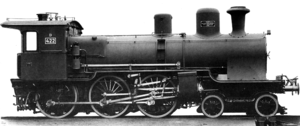| Württemberg D DRG 38.1 • PKP Ok102 | |||||||||||||||||||||||||||||||||||||||
|---|---|---|---|---|---|---|---|---|---|---|---|---|---|---|---|---|---|---|---|---|---|---|---|---|---|---|---|---|---|---|---|---|---|---|---|---|---|---|---|
 No. 422 in a works photograph | |||||||||||||||||||||||||||||||||||||||
| |||||||||||||||||||||||||||||||||||||||
| |||||||||||||||||||||||||||||||||||||||
| |||||||||||||||||||||||||||||||||||||||
| |||||||||||||||||||||||||||||||||||||||
The Württemberg D was a class of 14 locomotives of the Royal Württemberg State Railways (Königlich Württembergische Staats-Eisenbahnenen, K.W.St.E.)
They were designed for the Ulm to Bretten via Stuttgart line. They were a four-cylinder de Glehn compound. They were capable of taking a train of 250 tonnes (250 long tons; 280 short tons) up a 1% (1 in 100) incline at a speed of 60 km/h (37 mph).
After the First World War, only eight locomotives went to the Deutsche Reichsbahn, who allocated them the numbers 38 101 to 38 108; however, they were not in active service, and were scrapped in 1924.
Four went to Poland, where the PKP classed them as Ok102. Two (426 and 429) went to France as reparations, and were allocated to the Chemins de fer de l'État, who renumbered them 230-985 and 230-986; they were little used, 230-986 was withdrawn circa 1930, and 230-985 was scrapped in 1934.[1]
They were equipped with type 2′2′ T tenders.
YouTube Encyclopedic
-
1/2Views:11 5781 764
-
DMax Doku über die RU 800 S von Schwietelsky in Baden Württemberg Teil 1
-
Rud. Prey hydraulic glass elevator at Bookholzberg railway station
Transcription
References
- ^ Davies 2001, p. 77.
- Davies, John (August 2001). Chemins de fer de l'État Locomotive List 1878–1938. Woodbridge, Queensland: Dr. John Davies. ISBN 0-7316-8442-7.
- Lohr, Hermann; Thielmann, Georg (1988). Lokomotiven württembergischer Eisenbahnen (EFA 2.6) (in German). Düsseldorf: Alba. ISBN 3-87094-117-0.
